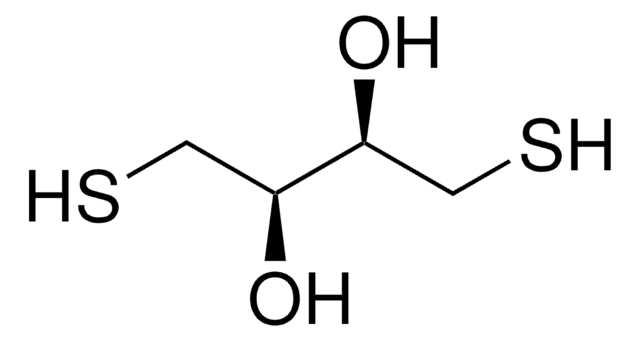Wichtige Dokumente
D9163
DL-Dithiothreitol
suitable for electrophoresis, ≥99%
Synonym(e):
threo-1,4-Dimercapto-2,3-butandiol, Clelands Reagens, DTT
About This Item
Empfohlene Produkte
Assay
≥99%
Form
powder
Eignung der Reaktion
reagent type: reductant
Methode(n)
electrophoresis: suitable
mp (Schmelzpunkt)
40-44 °C
41-44 °C (lit.)
Löslichkeit
H2O: 50 mg/mL, clear, colorless to very faintly yellow
Kationenspuren
heavy metals (as Pb): ≤10 ppm
Absorption
≤0.04 at 280 at 0.02 M
Lagertemp.
2-8°C
SMILES String
O[C@H](CS)[C@H](O)CS
InChI
1S/C4H10O2S2/c5-3(1-7)4(6)2-8/h3-8H,1-2H2/t3-,4-/m1/s1
InChIKey
VHJLVAABSRFDPM-QWWZWVQMSA-N
Suchen Sie nach ähnlichen Produkten? Aufrufen Leitfaden zum Produktvergleich
Anwendung
Hinweis zur Analyse
Signalwort
Danger
H-Sätze
Gefahreneinstufungen
Acute Tox. 4 Oral - Eye Dam. 1 - Skin Irrit. 2
Lagerklassenschlüssel
11 - Combustible Solids
WGK
WGK 2
Flammpunkt (°F)
Not applicable
Flammpunkt (°C)
Not applicable
Persönliche Schutzausrüstung
dust mask type N95 (US), Eyeshields, Faceshields, Gloves
Hier finden Sie alle aktuellen Versionen:
Besitzen Sie dieses Produkt bereits?
In der Dokumentenbibliothek finden Sie die Dokumentation zu den Produkten, die Sie kürzlich erworben haben.
Kunden haben sich ebenfalls angesehen
Unser Team von Wissenschaftlern verfügt über Erfahrung in allen Forschungsbereichen einschließlich Life Science, Materialwissenschaften, chemischer Synthese, Chromatographie, Analytik und vielen mehr..
Setzen Sie sich mit dem technischen Dienst in Verbindung.




